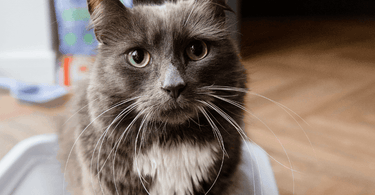Do you currently use clay litter and wonder about its impact on the environment? But you don’t want to compromise on the superior odour control of clumping litter? There is a solution: sustainable and eco-friendly wood and corn clumping cat litter. Not only is it a better choice for the planet, but it also has a long list of benefits for both you and your cat or kitten.
Made from renewable resources, this litter is biodegradable and compostable, making it a more environmentally friendly and responsible option. It's also lightweight and makes cleaning out litter trays very easy, so less hassle for you. Plus, it's free from harmful chemicals and fragrances, making it a better choice for your cat's sensitive respiratory system and sensitive noses. If you want to make a positive impact on the environment and your cat's health, consider switching to wood and corn clumping cat litter today.
Benefits of using sustainable and eco-friendly cat litter
There are a number of benefits to using sustainable and eco-friendly wood and corn based cat litter. For one, it's a more environmentally responsible option than traditional clay litter. Traditional clay litter is made from strip-mined clay, which is a non-renewable resource and has a significant impact on the environment. In addition, the production process for clay litter requires a significant amount of energy and water, which contributes to carbon emissions.
Sustainable and eco-friendly cat litter, also known as natural litter, on the other hand, is made from renewable resources like wood and corn. This means that it's more sustainable and has a lower environmental impact. In addition, sustainable cat litter is biodegradable and compostable, which means that it breaks down naturally and doesn't contribute to landfill waste. We cover how to compost cat litter in our Litter Guide.
Another benefit of using sustainable cat litter is that it can be better for your cat’s health. Traditional clay litter often contains harmful chemicals and fragrances that can irritate your cat's respiratory system. Cat litter made from wood and corn, on the other hand, is free from these chemicals and fragrances, making it a healthier choice for your cat.
What’s the difference between natural litter (wood cat litter, corn cat litter or a combination of the two), silica cat litter and traditional clay cat litter?
In this section we'll look at the differences between wood cat litter, corn cat litter, silica cat litter, non-clumping clay litter and clumping clay litter.
What is clay cat litter made from and how is it made?
Traditional clay cat litter has been the go-to option for cat owners for decades. Those of us who grew up with cats in our households almost certainly remember the little white stones in our cats’ litter trays. You probably also remember lugging very heavy bags of the clay litter around the house and having to empty the litter tray very regularly, sometimes on a daily basis if you had more than one cat.
Traditional non-clumping litter is usually made from calcium silicate or clay crystals. Believe it or not, some brands use smashed up concrete blocks to make their clay litter.
Over the past few years, clumping clay litter has been introduced to the market. This is usually made by adding bentonite to traditional clay litter, generally in the form of sodium bentonite or calcium bentonite. Whilst this does create an ultra absorbent clay litter, it causes severe damage to the ecosystem. This is due to the mining methods used to source bentonite.
Strip mining destroys entire ecosystems as the top level of the Earth’s surface is removed. The damage is far reaching. It means that the wildlife habitats and forests are completely destroyed and cleared. This also results in soil erosion and therefore reduces the likelihood of this land being used for agriculture.
Bentonite clay is also known to contain silica dust which is proven to be carcinogenic. Exposure to silica dust can lead to the development of lung cancer, silicosis, kidney disease and pulmonary disease in humans.
What is silica cat litter made from and how is it made?
Silica or crystallised cat litters are formed from a silica gel. This gel is absorbent and also provides odour control. Silica gel is a crystallised form of silicon dioxide. Silica litter is derived from sand – a non-renewable resource.
Some cat owners are surprised to discover that the silica used in these products is similar to the substance found in pouches that act as a preservative in medicine bottles and other products that can be damaged by moisture. It can therefore prove dangerous if ingested by your cat.
What is corn cat litter made from and how is it made?
Clumping corn cat litter, like Tippaws Long-lasting Clumping Litter, is made from renewable resources. In the case of Tippaws, corn is sourced as a by-product of the human food industry.
The production process for corn clumping cat litter involves heating and compressing the raw materials into granules. The granules are then sifted to remove any dust or small particles. The addition of our patented anti-bacterial clumping agent is then added. This acts as a natural binding agent when it comes into contact with cat urine that allows it to clump when wet.
What is wood cat litter made from and how is it made?
Wood clumping cat litter, like Tippaws Long-lasting Clumping Litter, is made from renewable resources. In the case of Tippaws, the wood is sourced as a by-product of the lumber industry.
The production process for wood clumping cat litter involves heating and compressing the raw materials into granules. The granules are then sifted to remove any dust or small particles. The addition of our patented anti-bacterial clumping agent is then added. This acts as a natural binding agent when it comes into contact with cat urine that allows it to clump when wet.
Tippaws Long-lasting Clumping Litter is a mix of wood and corn.
Advantages of wood and corn cat litter for your cat's health
One of the advantages of using wood and corn clumping cat litter is that it's healthier for your cat. Traditional clay litter often contains harmful chemicals and fragrances that can irritate your cat's respiratory system. Sustainable cat litter, on the other hand, is free from these chemicals and fragrances, making it a healthier choice for your cat. In fact, the only smell is that of the wood and perhaps a slight corn smell.
In addition, sustainable cat litter is lightweight and easy to clean, which means that it produces less dust than traditional clay litter. This is important because dust can be harmful to your cat's respiratory system, especially if they have sensitive lungs or allergies.
Cost-effectiveness of sustainable cat litter
While sustainable and eco-friendly cat litter may cost more upfront than traditional clay litter, it's actually more cost-effective in the long run. This is because sustainable cat litter lasts longer than traditional clay litter. You can use our waste savings calculator to see how much litter you’d save in a year by switching to a natural clumping litter Tippaws Long-lasting Clumping Litter, and therefore how much you’ll save in the long run.
Traditional clay litter needs to be completely replaced every few weeks, which can add up in cost over time. Sustainable cat litter, on the other hand, only needs to be topped up as needed, which means that it lasts longer and is more cost-effective in the long run.
We always say: don’t forget to include the cost of your time too. We are also busy working, whether that’s running our own companies, working in a corporate job, shift work or working in cat rescue shelters. Our time is invaluable and so you’ll be surprised adding up the time you save by not doing regular tray changes!
Environmental impact of wood and corn clumping cat litter
Wood and corn clumping cat litter has a significantly lower environmental impact than traditional clay litter. This is because it's made from renewable resources like wood and corn, which are more sustainable than the non-renewable clay used in traditional litter.
In addition, sustainable cat litter is biodegradable and compostable, which means that it breaks down naturally and doesn't contribute to landfill waste. This is important because traditional clay litter can take hundreds of years to break down in landfill sites, which contributes to environmental pollution and greenhouse gas emissions.
Customer reviews and testimonials of wood and corn cat litter
Many cat owners who have switched to our long-lasting wood and corn clumping cat litter have reported positive results. They praise the litter's lightweight and easy-to-clean nature, as well as its lack of dust and harmful chemicals.
One customer wrote, "I’ve had my cat for 11 years and I’ve never found a decent cat litter that clumps well, doesn’t smell and doesn’t track all over my house. Everyone with a cat understands how annoying litter tracking is, so this was high up on my requirements for a new litter. Having tested this litter now for a couple of weeks, I can honestly say it’s one of the best I have tried, if not the best. There’s no smell, it clumps really well and there is little to no tracking all over my small house! And best of all, it’s produced from natural materials. Thank you for selling such a great litter. I will be buying again!"
Tips for using, maintaining and disposing of eco-friendly cat litter
When using wood and corn clumping cat litter, it's important to follow a few tips to ensure that you're using it correctly and disposing of it responsibly. You can find these steps in our comprehensive Litter Guide.
The most important tip which is worth pointing out here is that regularly scooping is absolutely key, we cannot stress this enough! If you don’t keep on top of your scooping (1-2 times a day), you will lose all the benefits of a natural clumping litter as the clumps will start to break down when kicked by your cat and urine soaked litter will be mixed with fresh litter.
Common concerns and misconceptions about corn-based cat litter
As with any product, there are common concerns and misconceptions surrounding corn-based cat litter that are important to address. One concern is the potential for attracting pests such as rodents or insects due to the organic nature of corn-based litter. However, when stored properly in a secure container or bag, the risk of attracting pests is minimal.
Another misconception is that corn-based cat litter can be harmful if ingested by cats. While it's always important to monitor your cat's behaviour around litter, corn-based litter is generally safe if ingested in small amounts. However, if you have any concerns about your cat's behavior or health, it's best to consult with a vet for professional advice.
Conclusion and recommendation for switching corn cat litter, wood cat litter or a combined wood and corn cat litter
In conclusion, wood and corn clumping cat litter is a more sustainable and eco-friendly option than traditional clay litter. It's made from renewable resources, biodegradable, and compostable, making it a more environmentally responsible option. It's also lightweight and easy to clean, which means less hassle for you, and free from harmful chemicals and fragrances, making it a healthier choice for your cat.
If you're a cat owner who wants to make a positive impact on the environment and your cat's health, consider switching to wood and corn clumping cat litter today. Not only will you be doing your part to reduce your carbon footprint, but you'll also be providing your cat with a healthier and more comfortable litter tray experience.
Subscribe to our newsletter to get 10% off your first order.

